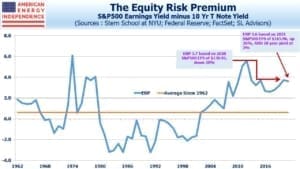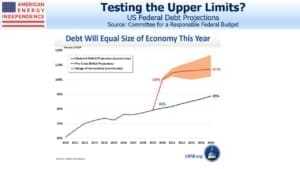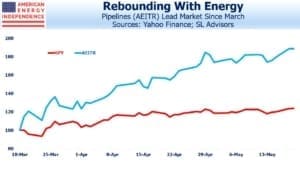Stocks Look Past The Recession and Growing Debt
At Berkshire’s virtual annual meeting recently, Warren Buffett mused that their cash hoard of $135BN didn’t seem that much. Stanley Druckenmiller said, “The risk-reward for equity is maybe as bad as I’ve seen it in my career.” The New Yorker thinks stock investors have lost their minds.
To not be bearish is to be insensitive – as if to dismiss the deaths and pandemic as economically meaningless.
Being negative is easy. Just think of all the closed stores, restaurants and sports events that have dramatically reduced options for leisure. I rarely need to visit the ATM because all I’m buying is gasoline, about once a month. It’s cheaper too, although I’d need to drive to a couple of planets for the savings to offset recent losses on my energy investments.
The S&P500 is -8% for the year, a performance seemingly divorced from reality. Following last year’s +31.5%, it might have been down 8% without coronavirus.
From a top-down perspective it’s usually easy to be bearish. There’s always something to worry about. But S&P500 earnings are estimated to be -20% this year and +27% in 2021, taking them back above last year’s. This is based on analyst estimates from early May, so for the most part reflects first quarter earnings and full year guidance. It’s hard to reconcile with the jump in the unemployment rate from 4.4% to 14.7%, but we must assume that’s incorporated in all those earnings forecasts.
The Equity Risk Premium (ERP, S&P500 earnings yield minus ten year treasury yield) still makes stocks look reasonably attractive. This is partly because interest rates are so low. But even if ten year treasury yields move up to 2% next year, equal to the Fed’s long term inflation target, the expected rebound in earnings will compensate.
If in fact earnings do rebound as forecast, it’s hard to see interest rates staying this low. For years bond investors have seemingly held a less optimistic view than equity investors, but the dichotomy seems as stark as it’s ever been.
To illustrate, Williams Companies (WMB) issued ten year debt at a yield of 3.56%, substantially below the dividend yield on their shares of 8.2%. Like many big pipeline companies, quarterly earnings were better than expected (see More Solid Pipeline Results). WMB’s quarterly payout is up 5.3% year-on-year.
Although the ERP shows stocks to be cheap, Goldman’s forecast of $44 in 2020 S&P500 dividends is only a 1.5% yield .
We’re heading into a period with no obvious historical precedent. A shut down of large swathes of the economy along with a big increase in debt is most analogous to war. The Committee for a Responsible Federal Budget now expects a Federal deficit of $3.8TN (versus $1.1TN pre-Coronavirus). They expect total Debt:GDP to reach 107% by 2023, exceeding the prior record of 106% hit just after the end of World War II. And these figures exclude any new Federal spending, although the House of Representatives recently passed another $3TN package.
Given the dismal fiscal outlook, the stock market’s recent performance is even more impressive. And if you’re looking for a sector that’s rebounded nicely but is still down over 30% for the year, check out the pipeline sector.
Important Disclosures
The information provided is for informational purposes only and investors should determine for themselves whether a particular service, security or product is suitable for their investment needs. The information contained herein is not complete, may not be current, is subject to change, and is subject to, and qualified in its entirety by, the more complete disclosures, risk factors and other terms that are contained in the disclosure, prospectus, and offering. Certain information herein has been obtained from third party sources and, although believed to be reliable, has not been independently verified and its accuracy or completeness cannot be guaranteed. No representation is made with respect to the accuracy, completeness or timeliness of this information. Nothing provided on this site constitutes tax advice. Individuals should seek the advice of their own tax advisor for specific information regarding tax consequences of investments. Investments in securities entail risk and are not suitable for all investors. This site is not a recommendation nor an offer to sell (or solicitation of an offer to buy) securities in the United States or in any other jurisdiction.
References to indexes and benchmarks are hypothetical illustrations of aggregate returns and do not reflect the performance of any actual investment. Investors cannot invest in an index and do not reflect the deduction of the advisor’s fees or other trading expenses. There can be no assurance that current investments will be profitable. Actual realized returns will depend on, among other factors, the value of assets and market conditions at the time of disposition, any related transaction costs, and the timing of the purchase. Indexes and benchmarks may not directly correlate or only partially relate to portfolios managed by SL Advisors as they have different underlying investments and may use different strategies or have different objectives than portfolios managed by SL Advisors (e.g. The Alerian index is a group MLP securities in the oil and gas industries. Portfolios may not include the same investments that are included in the Alerian Index. The S & P Index does not directly relate to investment strategies managed by SL Advisers.)
This site may contain forward-looking statements relating to the objectives, opportunities, and the future performance of the U.S. market generally. Forward-looking statements may be identified by the use of such words as; “believe,” “expect,” “anticipate,” “should,” “planned,” “estimated,” “potential” and other similar terms. Examples of forward-looking statements include, but are not limited to, estimates with respect to financial condition, results of operations, and success or lack of success of any particular investment strategy. All are subject to various factors, including, but not limited to general and local economic conditions, changing levels of competition within certain industries and markets, changes in interest rates, changes in legislation or regulation, and other economic, competitive, governmental, regulatory and technological factors affecting a portfolio’s operations that could cause actual results to differ materially from projected results. Such statements are forward-looking in nature and involves a number of known and unknown risks, uncertainties and other factors, and accordingly, actual results may differ materially from those reflected or contemplated in such forward-looking statements. Prospective investors are cautioned not to place undue reliance on any forward-looking statements or examples. None of SL Advisors LLC or any of its affiliates or principals nor any other individual or entity assumes any obligation to update any forward-looking statements as a result of new information, subsequent events or any other circumstances. All statements made herein speak only as of the date that they were made. r
Certain hyperlinks or referenced websites on the Site, if any, are for your convenience and forward you to third parties’ websites, which generally are recognized by their top level domain name. Any descriptions of, references to, or links to other products, publications or services does not constitute an endorsement, authorization, sponsorship by or affiliation with SL Advisors LLC with respect to any linked site or its sponsor, unless expressly stated by SL Advisors LLC. Any such information, products or sites have not necessarily been reviewed by SL Advisors LLC and are provided or maintained by third parties over whom SL Advisors LLC exercise no control. SL Advisors LLC expressly disclaim any responsibility for the content, the accuracy of the information, and/or quality of products or services provided by or advertised on these third-party sites.
All investment strategies have the potential for profit or loss. Different types of investments involve varying degrees of risk, and there can be no assurance that any specific investment will be suitable or profitable for a client’s investment portfolio.
Past performance of the American Energy Independence Index is not indicative of future returns.





Leave a Reply
Want to join the discussion?Feel free to contribute!